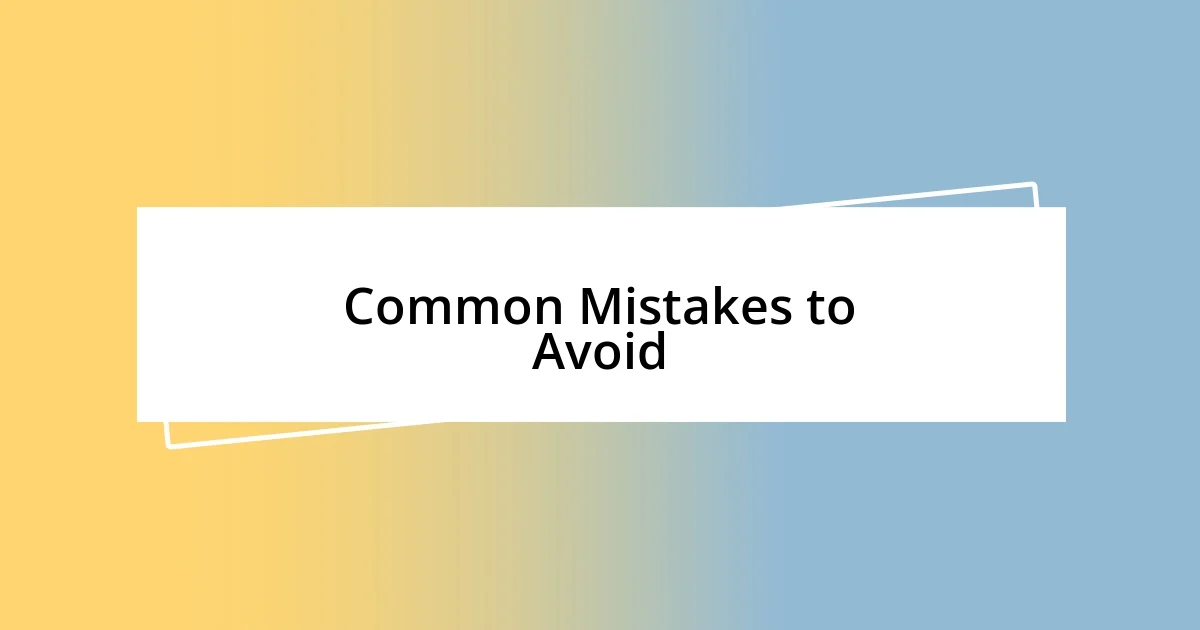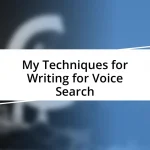Key takeaways:
- Crafting compelling meta descriptions is essential for increasing engagement and click-through rates, serving as the first impression for potential readers.
- Effective meta descriptions should typically be 150-160 characters, utilize action-oriented language, and include relevant keywords to enhance both SEO and audience connection.
- Continuous A/B testing and audience research are crucial for understanding reader preferences, improving descriptions, and ensuring content authenticity.

Understanding Meta Descriptions Importance
When I first started crafting meta descriptions, I underestimated their power. I remember publishing an article with a bland description, only to realize later that it barely generated clicks. This experience taught me that a compelling meta description is essential; it’s your first and often only chance to entice potential readers.
Think about it: how often do you skim search results and click solely based on the snippet you see? A well-written meta description doesn’t just summarize; it evokes curiosity and emotions. I always aim to create a sense of urgency or excitement in my descriptions. It’s fascinating how the right words can significantly increase engagement!
Furthermore, meta descriptions play a crucial role in SEO. They provide context to search engines about the content of your page. I’ve noticed that pages with optimized descriptions tend to rank better, providing both visibility and credibility. Isn’t it amazing how a few sentences can influence not just clicks, but also the perception of your content?

Elements of Effective Meta Descriptions
When I think about effective meta descriptions, I always remember the importance of length. Ideally, they should be between 150-160 characters; this way, you ensure your full message appears in search results without being cut off. I once crafted a description that exceeded this limit, and I was frustrated to see it truncated. It reminded me how crucial it is to be concise while still conveying key information.
In my experience, incorporating action-oriented language can make a huge difference. Phrasing like “Discover” or “Learn” creates a sense of urgency and invites readers to take action. I feel that when I speak directly to potential visitors, using an engaging tone, it resonates better. For instance, using “Unlock the secrets to…” instead of a bland statement draws people in. It’s a small change, but it profoundly impacts engagement.
Lastly, I’ve found that including target keywords is not just beneficial but essential. Not only does it improve SEO, but it also aligns with user intent. The moment I started weaving relevant keywords into my meta descriptions, I noticed a stark contrast in click-through rates. I’ve learned that balancing keyword optimization with creative flair can transform an average snippet into a compelling calling card.
| Element | Description |
|---|---|
| Length | 150-160 characters for full visibility |
| Action-Oriented Language | Encourages clicks and fosters engagement |
| Keyword Inclusion | Boosts SEO and matches user intent |

Researching Target Audience Needs
When diving into researching my target audience, I realized that understanding their needs is fundamental to crafting effective meta descriptions. I recall spending hours sifting through user comments and analytics on previous posts. It became clear that listeners crave clarity and value. By segmenting my audience based on their queries and feedback, I could pinpoint exactly what kind of content piqued their interest. This process opened my eyes to the array of emotions and expectations that different demographics bring to the table.
- Analyze user comments and feedback for insights.
- Utilize analytics to understand browsing behavior.
- Create audience personas to tailor content more effectively.
- Test different meta descriptions based on audience preferences.
- Regularly revisit audience research to stay current with trends.
Engaging with my audience often feels like a journey, each interaction shaping my understanding of their motivations. For example, after implementing feedback from a few avid readers, I noticed a significant uptick in engagement. It’s fascinating how tuning into the emotional undercurrents of your audience—like their search frustrations or curiosities—can lead to meta descriptions that truly resonate. The more I listen, the more I can translate their needs into compelling content that draws them in.

Tips for Writing Engaging Descriptions
When writing engaging meta descriptions, one tip that I always prioritize is to consider the emotional impact of my words. For instance, I once experimented with two distinctly different phrases for the same content. I found that when I used emotionally charged terms like “transform” versus more neutral verbs like “create,” the former drew in significantly more clicks. It made me realize how powerful emotions can be in motivating actions, so I now strive to tap into my reader’s feelings.
Another effective strategy is to pose a question that directly relates to the reader’s needs or desires. This technique has worked wonders in my experience. For example, crafting a description like “Are you ready to boost your productivity?” not only piques curiosity but also encourages a sense of urgency. It’s as if you’re starting a conversation, prompting the reader to think, “Yes, I want that!” This method can be surprisingly engaging and can entice more clicks as potential visitors see their own challenges reflected in your words.
Finally, a great practice I’ve adopted is to use A/B testing to refine my meta descriptions continuously. After implementing changes in several descriptions, I’ve discovered which tones and phrases resonate best with my audience. There’s something incredibly enlightening about analyzing the data; it’s like piecing together a puzzle of what captivates my readers. I ask myself, “What made this description appealing?” and use those insights to tweak my approach. Each time, I feel a sense of accomplishment and anticipation, wondering how the next round of testing will go.

Testing Meta Descriptions Performance
One of the most enlightening experiences I’ve had with testing meta descriptions was when I decided to take a more scientific approach. By setting up A/B tests for various descriptions on a few key articles, I was amazed to see how even the smallest wording changes could lead to substantial variations in click-through rates. For instance, switching “Discover how to succeed” to “Unlock your potential today” not only increased engagement but also sparked conversations among readers, affirming the power of choice in language.
I remember feeling a blend of excitement and nervousness each time I analyzed the results. At one point, I noticed that a description I thought was appealing got less traction than another that seemed straightforward. It made me question: what do we, as writers, sometimes miss about our audience’s preferences? This introspection helped me realize that my assumptions don’t always match their realities, reinforcing the importance of continuous testing and adaptation to truly resonate with readers.
Another valuable lesson emerged when I incorporated emotional triggers into my descriptions. I tried phrases that evoked curiosity or urgency and was surprised by how they impacted user behavior. I once crafted a description that said, “Are you tired of spending hours on pointless tasks? Let’s fix that!” The instant feedback from my audience was striking, and I felt a real connection. It drove home the idea that testing isn’t just about data; it’s about understanding our readers on an emotional level and tailoring our approach accordingly. Isn’t it fascinating how our words can shape decisions and impact someone’s day?

Common Mistakes to Avoid
A common mistake I’ve encountered while crafting meta descriptions is overstuffing keywords. I once fell into this trap, thinking that cramming in as many relevant terms would boost my search engine rankings. Instead, it made my writing feel mechanical and off-putting. I realized that a natural flow of words resonates much more with readers. After all, wouldn’t you prefer an engaging description that feels relatable instead of a robotic list of keywords?
Another pitfall to avoid is ignoring the importance of character limits. I remember a time when I wrote a description that was so enticing but exceeded the typical 155-160 character guideline. The results? My beautiful prose got cut off in search results, leaving potential clicks with unanswered questions. It taught me that brevity is just as crucial as creativity; you need to deliver a complete message within those character constraints.
Lastly, failing to match the meta description with the actual content is something I’ve had to learn the hard way. I’ve played with enticing phrases that promised more than what the article delivered, leading to disappointment for the reader. It’s a reminder that authenticity is key – delivering what you promise builds trust and keeps visitors coming back. Have you ever clicked on a link only to find something different than expected? It’s frustrating and definitely something I strive to avoid in my writing.

Optimizing Meta Descriptions for SEO
When optimizing meta descriptions for SEO, I’ve found that being concise yet compelling is crucial. My experience has been that the most effective descriptions are around 155-160 characters, and it’s fascinating how often I’ve tested this. I remember a specific time when I managed to condense a lengthy description into a punchy, engaging one that perfectly fit the character limit. Suddenly, I saw a noticeable spike in traffic. It made me realize that brevity can work wonders when you choose the right words.
In another instance, I focused on including a clear call-to-action in my descriptions. Phrases like “Learn more” or “Join us today” proved to be game-changers, converting casual browsers into eager visitors. There was a moment when I shifted the description from a passive tone to one that invited action, and it felt rewarding to see how it resonated with my audience. It’s almost as if what I said transformed their curiosity into motivation. Have you noticed how a simple shift in tone can alter engagement levels?
Moreover, I cannot stress enough the significance of aligning your meta descriptions with user intent. I once crafted a description for an article that didn’t quite resonate with what users expected to find. The realization hit me as I watched the click-through rate drop; it opened my eyes to the importance of understanding audience needs. I think about how vital it is for our descriptions to promise exactly what the content delivers – it not only enhances user experience but also reinforces our credibility as writers. Don’t you think that meeting user expectations lays the foundation for a lasting relationship with your audience?














